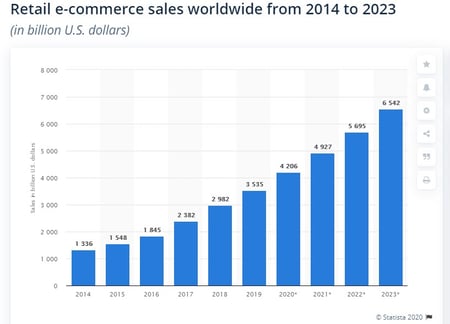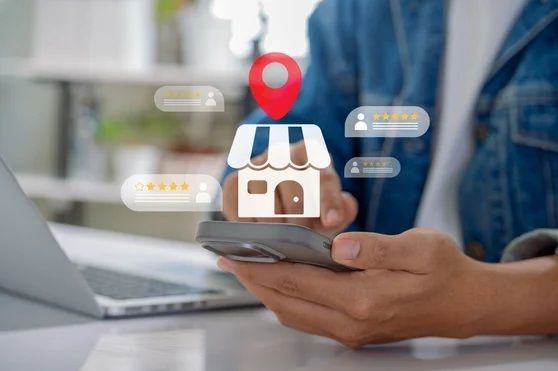A Guide to Getting Online: Part One – Business Strategy

Summary: If you are considering getting started with eCommerce during COVID-19, this first part of our three-part blog series will help you get started.
There is no doubt that these are unprecedented times, and while my grandmother might have remembered the ‘Spanish Flu’ living through a pandemic like this is a new and scary experience. However, if we look at the impact of SARS on consumer behavior in China and AP, then we can get an inkling of what might happen post-COVID 19 – SARS catapulted China forward to be the leading online economy.
eCommerce has been growing quickly and steadily for the last 10 to 15 years as the data from Statistica shows. Still, I believe one of the significant impacts of COVID-19 will be to accelerate that acceptance and growth. We see new groups of people being introduced to doing new things online that they may not have considered everything previously from working from home to online gym sessions to grocery click and collect – and finding that they like the experience.

So how should a business owner approach the transition online?
To me, the questions fall into three areas needed for success:
- Business Strategy – Why am I doing this?
- The Technology – What platforms and technology are needed?
- Driving the Business – How do I get the traffic (customers) I need to be successful?
I’ll return to the 2nd and 3rd areas in later posts, but for now, let us look at the strategy question.
The Business Strategy – How Will You Compete?
As Jack Welch famously said, ‘If you don’t have a competitive advantage, don’t compete.’
Just because you build a website, customers will not just come and buy from it – if only things were that simple and if you are thinking about pivoting towards eCommerce as a short term fix, my best advice is don’t do it.
eCommerce is a strategic shift of behavior, so think about it that way. Traditional retail will recover, but your customers will have different expectations, and what gave you a competitive advantage in the past may no longer be accurate. Conventional benefits like geographic location or pricing are much harder to sustain online than in the real world.
Pricing is very transparent (and expected to be) online, so if your business model is all about hidden discounts or rebates, you might be in trouble. Being the cheapest is not always desirable or necessary, but you do need to be competitive. You need to think differently about what you bring to the table that will encourage people to buy from you if you are an expert in sourcing niche products that is good. If you can use your expertise to help people make the right choices, that is great because often the problem online is too much choice and knowing who to trust. If you provide a niche or specialized product, then even better-this is the channel for you.
Local can still be a good reason to differentiate, but that does limit the audience you are addressing. Your store must talk about who you are as a brand or retailer, what your mission is, what you believe in, and why people should buy from you. If you can’t articulate this, then you will be at a disadvantage. Your thinking needs to change not to where am I located in terms of footfall but who is my audience, what are the problems I can solve for them, and how do I connect to them digitally.
To compete, you must also harness the two-way nature of the Web. Online gives you a different (and sometimes deeper) connection to your customers. A means to connect with them digitally and to understand what they are looking for and what solutions you can provide for them. The best online merchants know that this is a two-way street and use their connected customers to guide their direction and decisions in a way that is much more difficult to do in the bricks and mortar world. Your customer list and the consent you have collected to engage that audience is a real measure of the value of your business into the future. This is important to focus on this in your strategy because it is the only way to counter the reduced loyalty people generally feel online and the fact that there is a world of competition only a click away.
The world is not going to be completely online – so how does your online presence support your Bricks and Mortar store or your sales team in the field? This can be a real concern for businesses and brands. My experience is making sure everyone is in on a standard set of incentives, and pricing is transparent in all channels goes a long way to solving any concerns. Multi-channel works well today.
How Can I Help, Sir?
No successful salesperson ever started a conversation in a shop with – What can I sell you? People want help, and they will return to the brands, owners, and retailers that help them the most. The difference in eCommerce is that your digital assets and content are what will help your customers now, not your sales assistants. You have to focus on the problems you solve and the needs you satisfy for your customers and how to do that digitally.
So whether you like it or not, you are now in the content business – for many, this is a new skill set that needs to learned or acquired.
If you are selling products, you need great product descriptions, features, but also benefits. If you have content showing the product in use, that’s great. If you don’t, consider creating it for your top 20 products.
There are no ifs, buts, or maybes with this. Nothing will sabotage your online eCommerce business quicker than poor product images and descriptions. You, as the business owner, must think about how your team will provide this content and, by the way, increasingly that should be in video format. Some stores report that conversion rate (the ratio of people who purchase a product) can increase by 174% if they watch a product video. I guess maybe those late-night TV shopping channels did sell some stuff!
Business Strategy – The Team
First and foremost, online is still a business, so all of the fundamental business skills around operations, finance, customer service, etc. remain the same, but there are some new ones you need.
It certainly helps to have access to someone who has broad digital experience. Who can help you put all the pieces together? Just like you don’t expect your shopfitter to be an expert in marketing, your web developer may not be the right person to help you drive the business forward. (Don’t get me wrong your web developer is a crucial member of the team – just don’t ask them to do things that are outside their skill range) A highly focused SEO agency will not be able to help with customer proposition or email communications, for example.
As you grow, you can undoubtedly bring specific skills to your team. In the beginning, you probably should engage some consulting help to build the broader roadmap and plan in how you are going to grow and sustain the business. You do need as a core skill a Marketeer or merchandiser who understands your business but don’t expect them to be able to put together and execute the broad range of tactics needed to make this a success.
Analytics and understanding your data will be crucial to success. You can outsource in the beginning to have it set up correctly, but you can not be successful without understanding your data and what it is telling you. So start learning on the job or working with someone that can help you find your feet quickly.
Business Strategy – The Economics of Your New Business
Analytics brings me neatly to the final leg of your business strategy. You have to understand the new economics of what you are doing. It used to be the case that people believed that you got a lower price on the internet because businesses did not have all the traditional costs of real estate, staff assistants, or multiple partner margins. While that is partly true, there are a whole set of other expenses you need to consider, logistics/delivery, returns, payments and charge-backs, digital infrastructure costs, and, most importantly, demand generation and marketing costs.
While you may not be paying high street rents and rates for your online store, you are going to have to re-invest a significant proportion of your online revenue into generating quality and converting traffic. So make sure you build out a proper financial plan and P&L that accounts for these elements before you start. Make sure you understand the margins behind each product and how that allows you to scale your marketing correctly. Nothing worse than a nasty financial surprise.
Conclusion
I believe that almost every business needs to plan for at least 15-20% of its revenue to come from Online sources as you simply cannot concede that space to your competition anymore. COVID simply increases the imperative to do this.
But there is no magic here. Start by articulating your overall business strategy, how you will compete, how you will build the right team around you for success, and how to finance this correctly. You can start small and slow and grow from there – just make sure you have considered the road ahead.
WSI was founded in 1995 and is an innovative digital marketing agency with offices in over 80 countries. We’ve spent over 20 years helping more than 100,000 companies and large global brands unlock the full potential of their business by leveraging the Internet and its many unrecognized opportunities. We’d be happy to help do the same for you and consult on your digital marketing strategy. Simply give me a call or email me at rknutsen@wsiebizsolutions.net to learn more.
About the Author
Rick spent 20 years in the insurance industry in finance, primarily developing reporting platforms for B & C stakeholders. His ability to speak to consumers of data (managers and analysts) and translate their needs to programmers led him to start his own digital marketing agency in 2004 to develop data driven solutions for business owners.
The Best Digital Marketing Insight and Advice
We are committed to protecting your privacy. For more info, please review our Privacy and Cookie Policies. You may unsubscribe at any time.
Don’t stop the learning now!


